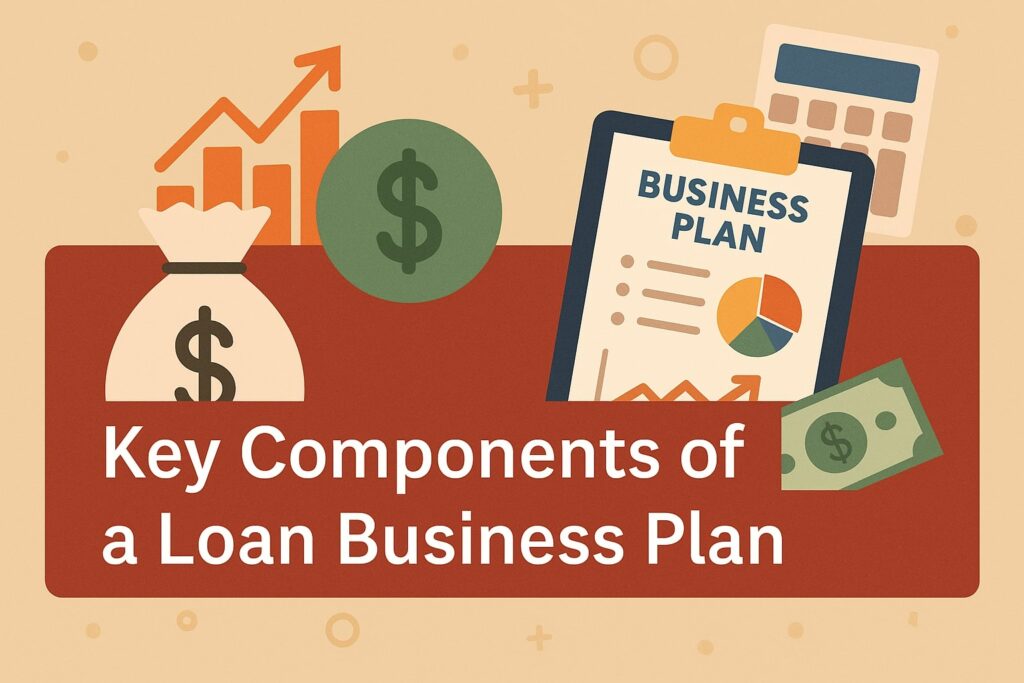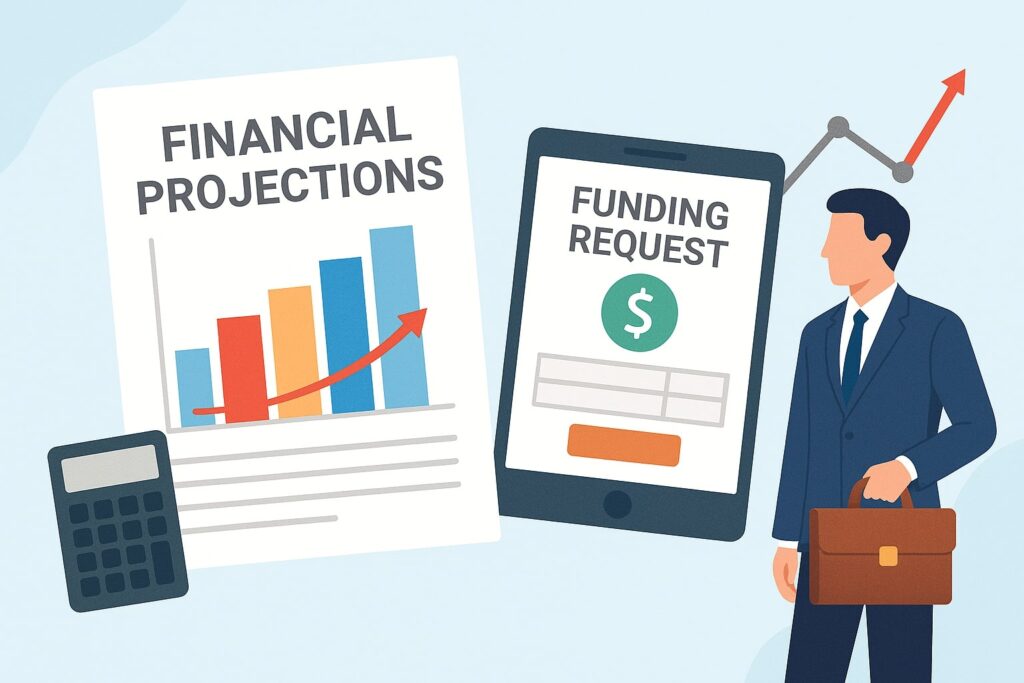
How to Write a Business Plan to Get a Loan
Writing a Business Plan to Get a Loan is a crucial step for any U.S. entrepreneur seeking bank or SBA financing. A well-crafted business plan not only guides your strategy but also convinces lenders of your venture’s viability.
In fact, lenders often require a detailed plan to minimize risk. Even if not explicitly required, having a solid plan bolsters your application, demonstrating to bankers that you’ve thoroughly vetted your business model.
Lenders evaluate loan requests using the “five Cs” of credit – Character, Capacity, Capital, Conditions, and Collateral – so your plan must address each area clearly.
In practice, this means showing strong management character (credit and track record), demonstrating capacity to repay (through cash flow), detailing owner capital investment, outlining collateral, and explaining market/loan conditions.
By aligning your plan with these criteria, you present a winning business loan proposal that lenders trust.
An entrepreneur drafting a loan-ready business plan. Even businesses with good credit often need a solid plan to reassure lenders.
Lenders and SBA programs usually expect comprehensive plans for any startup funding. As the SBA’s Lender Match tool notes, “Most lenders expect a business plan when you apply for startup funding”.
This plan should clearly state how much funding you need and how it will help the business. In short, your business plan is key to securing a loan: it tells the story of your business and proves you have a viable strategy to repay the debt.
Why a Business Plan is Essential for a Loan

Without a plan, lenders may not trust that you’ve fully thought through your venture. A business plan for a loan application acts as your pitch document, showing that you understand the market and your finances.
As Investopedia emphasizes, banks and investors often demand a plan to feel confident about funding your business. Preparing this plan forces you to research industry trends, competition, and financials so you can demonstrate the likelihood of success.
Moreover, the plan clarifies the amount and use of funds to the lender. By detailing exactly why you need the loan and how it will impact cash flow, you convince the bank that you will manage the money wisely and repay it.
For example, one SBA-backed expert explains that your plan must clearly “show how the funds will be used” and how you will repay the loan.
Lenders also examine your overall creditworthiness and preparedness. Credit history (Character) and existing assets (Collateral) are evaluated along with the plan. The SBA checklist explicitly highlights credit score and collateral as critical elements of any loan application.
In summary, a strong business plan tailored for a loan addresses the “five C’s” head-on – it shows lenders you’re character-strong, have capacity and capital, understand the conditions, and offer collateral if needed.
Key Components of a Loan Business Plan

To prepare a winning business loan proposal, include the critical sections lenders expect. An effective loan plan typically contains an Executive Summary, Company Description, Market Analysis, Organization & Management, Products/Services, Marketing/Sales Strategy, Operations Plan, Management Team, Funding Request, Financial Projections, and an Appendix.
These sections ensure you cover every aspect of the business and the loan request. For example, the SBA and business advisors commonly break a loan plan into these parts.
A complete loan business plan lays out sections from the Executive Summary through financials and appendices, as shown above. In practice, experts advise including these key elements:
- Executive Summary: A concise overview of the business and loan request. Briefly explain your company, mission, leadership, and the exact funding needed. Although it appears first, write this section last to summarize the highlights.
It should capture the lender’s interest and quickly communicate why your business will succeed. The executive summary should also mention the purpose of the loan and anticipated outcomes (e.g. growth projections). - Company Description: Detailed information about what your business does, its history, legal structure, and competitive advantages.
Describe the problems your product or service solves, who your customers are, and what differentiates you from others. If you have a prime location, special expertise, or proprietary technology, highlight it here. - Market Analysis: Research on your industry, target market, and competitors. Show that you understand demand, market size, trends, and who your customers are. Include data on market growth and key industry trends.
Discuss major competitors and their strengths and weaknesses. For example, identify who will buy your product, what need it fulfills, and how your company fits into the competitive landscape. Lenders want evidence of a proven market and realistic growth opportunities. - Organization & Management: Your company’s structure and leadership. Explain your legal form (LLC, corporation, etc.) and use an organizational chart if helpful. Introduce the owners and key managers, including brief bios and roles.
If applicable, describe the board of directors or advisors. The goal is to show the lender that your team has the experience and skills to execute the plan. Include resumes or CVs of key personnel in the Appendix. - Products or Services: What you sell and how it benefits customers. Describe each product or service line in detail.
Explain its life cycle, any research and development, and plans for innovation. If you have patents, trademarks, or proprietary technology, mention them. Lenders want to see clearly what you offer and why it’s valuable. - Marketing and Sales Strategy: How you will attract and retain customers. Outline your marketing plan: pricing, promotion, distribution, and sales tactics.
For instance, will you use online advertising, social media, trade shows, or partnerships? Also explain your sales process (e.g. direct sales team, online sales, retail).
Show you have a realistic strategy to reach your target market. A strong marketing plan will detail your customer profile and how you’ll position your brand vs competitors. - Production/Operations Plan: Your business’s operational roadmap. Describe how you will produce or deliver the product/service. Include information on facilities, equipment, technology, and supply chain.
Your lender needs confidence that you have the capacity to handle projected sales. For example, if you manufacture, detail production volume, quality controls, and vendors. If you provide services, explain workflows and capacity planning. - Management Team: (sometimes combined with Organization). Highlight the experience and track records of the owners and managers. Describe each key team member’s background and how they contribute to success.
If you have gaps in expertise, note how you’ll address them (e.g. hiring or consulting). This reassures lenders that qualified people are running the business. - Funding Request: (Use of Loan Proceeds) Clearly state how much money you are seeking and exactly what you will use it for. Specify the type of loan (e.g. SBA 7(a), line of credit), the amount of each disbursement, and repayment terms.
Detail how the funds will be applied: inventory, equipment purchase, renovations, hiring, etc. For example, NerdWallet advises explaining the exact amount of money requested and its purpose.
Also outline how the loan will be repaid: provide a repayment schedule and mention collateral if needed. Lenders want assurance your plan covers debt service fully. - Financial Projections: Detailed financial forecasts for the next 3–5 years. This is a critical section for lenders. Include projected income statements, balance sheets, and cash flow statements.
Break down assumptions for revenue growth, cost structure, and expenses. Conduct a break-even analysis to show when you expect to become profitable. For the first year, it’s best to provide monthly or quarterly projections. Your forecasts should tie directly to your funding request.
As one SBA guide notes, this is where graphs and charts can “tell the financial story of your business”. A transparent projection demonstrates your business’s stability and repayment capacity. - Appendix: Supplementary materials that support your plan. Include any documents that boost credibility. Common appendix items: personal and business credit reports, legal documents (leases, patents, licenses), contracts with suppliers or customers, market studies, letters of reference or customer testimonials, and resumes of key personnel.
Financial statements (e.g., past years’ income statements and tax returns) also go here. The Appendix shows your plan is fact-based and helps the lender verify your claims.
Together, these sections form the backbone of a business plan aimed at securing a loan. As one advisory source summarizes, a complete loan proposal should address each of these areas comprehensively. Covering all of them shows the lender that you’ve thought through every facet of the business and financing.
Financial Projections and Funding Request

Your financial plan is especially critical when seeking a loan. This section shows lenders the numbers behind your claims. You’ll attach detailed statements (income, cash flow, balance) in the Appendix, but summarize and explain key figures here.
First, outline your Funding Request: exactly how much money you need, the loan type, and the use of funds. Clarify whether you need a lump sum, line of credit, or phased funding over several disbursements.
Detail spending plans: for example, you might say “$50,000 to purchase new equipment, $20,000 for inventory, and $10,000 for marketing” and explain how each will grow the business. Always link the loan to revenue generation and repayment ability – lenders must see that the borrowed funds will increase your cash flow enough to service the debt.
Use tables and charts to present your numbers. A good practice is to include a 3- to 5-year projection table for revenue, expenses, and profit (with accompanying text explaining assumptions). For example, the table below shows a simple illustration of sales and costs over three years:
| Year 1 | Year 2 | Year 3 | |
|---|---|---|---|
| Revenue (USD) | 100,000 | 125,000 | 156,250 |
| Cost of Goods (USD) | 50,000 | 62,500 | 78,125 |
| Gross Profit (USD) | 50,000 | 62,500 | 78,125 |
| Operating Expenses (USD) | 30,000 | 36,000 | 43,200 |
| Net Profit (USD) | 20,000 | 26,500 | 34,925 |
Table: Example three-year financial projections (illustrative only).
These illustrative figures show how you might structure projections. In your plan, accompany any such table with a narrative explaining growth assumptions. Clearly explain pricing, market-share gains, cost controls, and how they lead to these numbers.
The lender will scrutinize your assumptions as much as the totals. Many experts recommend detailing assumptions in bullet points: e.g. annual sales growth rate, average price per unit, cost inflation, etc.
Include a break-even analysis so the lender can see when and how your venture becomes profitable. Also mention any additional capital sources.
Finally, explain your repayment strategy. State the proposed loan terms (interest rate, amortization), then show monthly or quarterly debt service in your cash flow. Discuss any collateral pledged – for instance, business assets or personal guarantees – since this reduces the lender’s risk.
Bankrate specifically advises including details on collateral and contingency plans: for example, “If sales fall short, we will maintain cash reserves and reduce variable expenses to cover loan payments”. Demonstrating that you have a safety net or co-signer can greatly reassure lenders.
Tips for Writing a Winning Loan Proposal

The presentation of your plan matters as much as its content. Keep your writing clear, concise, and reader-friendly. Avoid jargon and use plain language throughout. The BDC recommends writing in simple terms so any banker (even outside your industry) can understand your proposal.
Use short paragraphs, bullet lists, and headings to organize information logically. Remember the lender’s perspective: your goal is to sell your business idea as sound. Highlight your company’s strengths and explain why your venture will succeed.
Be honest and realistic – lenders will check your facts, so credibility is crucial. If possible, have someone else (a mentor or professional editor) review your draft for errors and clarity.
Formatting should look professional. Use a consistent font and layout, and include a title page with your company name and contact information. Include a table of contents with page numbers for easy reference.
Incorporate visual aids: charts, graphs, or tables that illustrate trends (e.g. sales growth, market share, financial ratios) can make complex data more digestible. One guide advises making the financials section “a great place to use graphs and charts to tell the financial story”.
Even in textual sections, you might include images or diagrams (for example, a process flowchart or organization chart) if they help clarify a point.
A few final pointers: proofread carefully and ensure consistency in numbers and formatting. Keep the plan concise – quality matters more than length. In practice, most lender-friendly plans run around 20–30 pages (excluding appendices).
Avoid overly lengthy narratives; focus on data, facts, and persuasive evidence. Use bullet points where appropriate to break up text. Each section should flow logically to the next, building a clear case that your business is a safe investment.
Tailoring the Plan to Your Business
While the outline above applies broadly, you should adapt details to your specific situation and industry.
- Startups and New Ventures: If you’re launching a new business, you won’t have historic financials. Emphasize market research, projections, and the strength of your business model.
Provide in-depth data on customer demand and competitor analysis. Clearly explain any innovative aspects or proprietary ideas. Lenders will closely watch your assumptions, so justify every projection with external data or pilot results.
Also highlight the founders’ experience and any advisers you have, since “industry experience” builds lender confidence. - Existing Small Businesses: If you already own a business, include past financial statements (tax returns, balance sheets) as proof of performance. Show historical growth trends and how the new loan will drive further expansion or efficiency.
For example, if applying for a loan to purchase new equipment, include ROI calculations or case studies of similar upgrades. Even as an experienced owner, formalizing your plan can uncover new insights and keep you focused. - Franchises: Lenders treat franchises somewhat differently. They will want to see the franchise system’s track record (or a copy of the Franchise Disclosure Document) and any requirements set by the franchisor.
Make sure to note in your plan whether the franchise is on the SBA’s approved list of franchise brands – being on that list often eases SBA financing. Explain the total investment, including franchise fees, startup costs, and working capital.
The ADP guide points out that banks usually expect franchisees to contribute a significant down payment (often 10–20%) and to have a detailed business plan with revenue/expense estimates.
Emphasize the franchise brand’s reputation: “financial institutions tend to be more inclined to work with franchises that are well-known and have a history of success”.
Ultimately, treat the franchise like any business: address the same plan sections, but include details on royalties, support from the franchisor, and any exclusive territories or resources provided. - Real Estate Ventures: For a real estate investment or development project, focus on the property analysis. Detail location, market rents/sales, zoning, and comparable properties. Include a financial plan that shows projected rental income, occupancy rates, or exit sale prices.
SmartAsset advises real estate investors to explain property use (e.g., rentals vs flipping) and investment strategy (how you’ll select and manage properties). Also include a robust risk management section – for instance, address how you’ll handle interest rate changes, market downturns, or regulatory compliance issues.
Since property is often collateral, specify the loan-to-value ratio and how property cash flows cover debt. In summary, tailor every section of the plan to address the realities of real estate finance, just as you would for products or services in other sectors.
In all cases, customize your language and examples to your industry. Instead of generic terms, use industry-specific data and terminology to show you know your field.
A plan for a restaurant franchise, for example, would analyze foot traffic and menu margins, while a tech startup’s plan might include patent strategy and software development milestones. Keeping the focus on your business type makes the plan more credible to the loan officer reviewing it.
Frequently Asked Questions
Q.1: What is a business loan proposal?
Answer: A business loan proposal is the document you submit when seeking financing. It details the amount of funding you need, how you will use the funds, and how you will repay the loan. Essentially, it is your complete business plan with emphasis on the funding request and payback strategy.
It provides the lender with a snapshot of your business’s current operations and financial health. Bankrate defines a loan proposal as the short-term document that “details the amount of funding you’re seeking, how you plan to use it and how you plan to pay it back”.
Q.2: Do I need a business plan to get a loan?
Answer: Many lenders require one. While smaller or informal loans may not strictly need a plan, most conventional banks and SBA lenders will want a full business plan for any substantial startup or expansion loan.
According to NerdWallet, “not all lenders will require a business plan, but you’ll likely need one for bank and SBA loans”. In practice, even if a lender doesn’t explicitly demand it, having a plan greatly improves your chance of approval by showing thorough preparation.
Q.3: What’s the difference between a business plan and a loan proposal?
Answer: A business plan is a broad document that outlines your company’s strategy, structure, and long-term growth. A loan proposal focuses more narrowly on your funding needs and how the business will generate enough income to repay the loan.
Bankrate explains that the loan proposal looks at how the business functions “over a smaller period” specifically to secure financing, whereas the business plan covers the overall roadmap of the company.
In practice, the loan application will usually want both: you present the full business plan plus a clear funding request section to detail the loan.
Q.4: What should I include in the Funding Request section?
Answer: Clearly state the loan amount and intended use. Explain what the money will buy (e.g. equipment, inventory, leasehold improvements) and how each expense ties to revenue generation. Also outline the desired terms (loan type, interest rate, repayment period).
Some lenders advise specifying whether you seek debt or equity funding. In any case, be specific: as one source puts it, “Explain what you’ll purchase with the funds — like if you plan to use it for fixed assets or working capital — and how you believe it will impact the business”. Detailing this thoroughly shows the lender you have a solid plan for the money.
Q.5: How many pages should my plan be?
Answer: Quality over quantity. A concise, focused plan (typically 20–30 pages) is ideal for loan applicants. After the first draft, trim any unnecessary fluff or overly detailed narrative. Lenders are busy; they prefer straight-to-the-point analysis and data.
Use bullet points and charts where appropriate, and keep paragraphs short. The First Business Bank advises keeping business plans “concise and focused” – in their experience, 20–30 pages (plus appendix) is a good guideline. Remember, it’s better to be a bit shorter and clearer than longer and repetitive.
Q.6: Where can I find templates or examples?
Answer: The U.S. SBA and affiliated organizations provide excellent resources. SCORE (a nonprofit supported by SBA) offers a free downloadable business plan template. In fact, First Business Bank’s guide recommends using the SCORE business plan template as a starting point.
The SBA website also provides sample plans (for various industries) which you can study. These templates will guide you on the key sections and formatting. Additionally, organizations like Investopedia and business finance blogs often offer outlines and tips for loan plans. Using a template can help ensure you don’t miss any vital component.
Conclusion
Writing a business plan to get a loan is a demanding but essential process. A thorough plan signals to lenders that your venture is well-conceived and that you are prepared to meet your obligations.
By covering every key element – from executive summary through financials – you reduce the lender’s uncertainty and build trust. As financial experts note, a comprehensive plan should be “clear, concise, and compelling” to convince bankers of your project’s viability. It should directly address how the loan will enable your business to grow and repay the debt.
Remember that a loan proposal is ultimately about credibility. Back up your projections with research, demonstrate your management team’s expertise, and be transparent about risks and contingencies. Use professional formatting (charts, tables, headings) to make the document easy to navigate.
In the end, a well-prepared loan proposal can make the difference between an enthusiastic nod from the loan officer and a request for more information. With the strategies outlined here and attention to detail, you can craft a winning business plan for a loan that stands the best chance of approval.